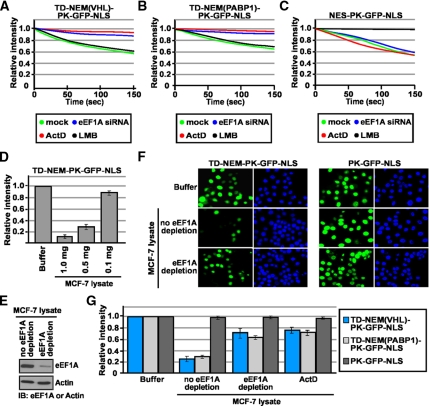Figure 9.
eEF1A is required for TD-NEM–mediated nuclear export. (A-C) TD-NEM nuclear export requires eEF1A and is independent of the CRM1/NES nuclear export pathway. MCF-7 cells were transiently cotransfected with the indicated constructs and 100 nM eEF1A siRNA for 48 h before being assessed by the live cell FLIP nuclear export assay. Where indicated, cells were transfected with the indicated constructs then treated with either 2 μM ActD or 10 μM LMB for 1 h before cytoplasmic FLIP. The loss of nuclear fluorescence was monitored and graphed. (D–G) eEF1A is required for nuclear export of TD-NEM in an in vitro export assay. (D) Protein levels in an MCF-7 cellular lysate were quantified using standard protein quantification methods. Buffer alone or cellular lysate containing different protein amounts in the presence of the ATP-, GTP-, and ATP-regenerating system were added to digitonin-permeabilized cells transiently expressing TD-NEM-PK-GFP-NLS. Nuclear export was monitored by loss of nuclear fluorescence. Relative loss in nuclear fluorescence was calculated and plotted on a graph. (E) MCF-7 lysate containing 0.5 mg of protein was depleted of eF1A using eEF1A specific antibody (see Materials and Methods for details). The depletion of eEF1A was assessed by Western blot analysis. Actin was used as a control. (F and G) MCF-7 cells transiently expressing the indicated constructs were permeabilized with digitonin and incubated with transport buffer alone, MCF-7 lysate, or MCF-7 lysate that was depleted of eEF1A. Where indicated cells were pretreated with 8 μM ActD for 3 h before permeabilization with digitonin and the nuclear export assay was performed using undepleted MCF-7 lysate containing 8 μM ActD. All conditions were performed in the presence of ATP-, GTP-, and ATP-regenerating system. Nuclear export was monitored by loss of nuclear fluorescence (F). Relative loss in nuclear fluorescence was calculated and plotted on a graph (G).

